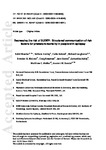Decreasing the risk of sudden unexpected death in epilepsy: structured communication of risk factors for premature mortality in people with epilepsy
| dc.contributor.author | Shankar, Rohit | |
| dc.contributor.author | Henley, W | |
| dc.contributor.author | Boland, C | |
| dc.contributor.author | Laugharne, R | |
| dc.contributor.author | McLean, BN | |
| dc.contributor.author | Newman, Craig | |
| dc.contributor.author | Hanna, J | |
| dc.contributor.author | Ashby, S | |
| dc.contributor.author | Walker, MC | |
| dc.contributor.author | Sander, JW | |
| dc.date.accessioned | 2018-06-12T13:00:17Z | |
| dc.date.issued | 2018-09 | |
| dc.identifier.issn | 1351-5101 | |
| dc.identifier.issn | 1468-1331 | |
| dc.identifier.uri | http://hdl.handle.net/10026.1/11647 | |
| dc.description.abstract |
BACKGROUND AND PURPOSE: Good practice guidelines highlight the importance of making people with epilepsy aware of the risk of premature mortality in epilepsy particularly due to sudden unexpected death in epilepsy (SUDEP). The SUDEP and Seizure Safety Checklist ('Checklist') is a structured risk communication tool used in UK clinics. It is not known if sharing structured information on risk factors allows individuals to reduce SUDEP and premature mortality risks. The aim of this study was to ascertain if the introduction of the Checklist in epilepsy clinics led to individual risk reduction. METHODS: The Checklist was administered to 130 consecutive people with epilepsy attending a specialized epilepsy neurology clinic and 129 attending an epilepsy intellectual disability (ID) clinic within a 4-month period. At baseline, no attendees at the neurology clinic had received formal risk advice, whereas all those attending the ID clinic had received formal risk advice on multiple occasions for 6 years. The Checklist was readministered 1 year later to each group and scores were compared with baseline and between groups. RESULTS: Of 12 risk factors considered, there was an overall reduction in mean risk score for the general (P = 0.0049) but not for the ID (P = 0.322) population. Subanalysis of the 25% of people at most risk in both populations showed that both sets had a significant reduction in risk scores (P < 0.001). CONCLUSION: Structured discussion results in behavioural change that reduces individual risk factors. This impact seems to be higher in those who are at current higher risk. It is important that clinicians share risk information with individuals as a matter of public health and health promotion. | |
| dc.format.extent | 1121-1127 | |
| dc.format.medium | Print-Electronic | |
| dc.language | en | |
| dc.language.iso | en | |
| dc.publisher | Wiley | |
| dc.subject | classification | |
| dc.subject | risk assessment | |
| dc.subject | risk stratification | |
| dc.subject | safety check list | |
| dc.title | Decreasing the risk of sudden unexpected death in epilepsy: structured communication of risk factors for premature mortality in people with epilepsy | |
| dc.type | journal-article | |
| dc.type | Journal Article | |
| dc.type | Research Support, Non-U.S. Gov't | |
| plymouth.author-url | https://www.ncbi.nlm.nih.gov/pubmed/29611888 | |
| plymouth.issue | 9 | |
| plymouth.volume | 25 | |
| plymouth.publication-status | Published | |
| plymouth.journal | European Journal of Neurology | |
| dc.identifier.doi | 10.1111/ene.13651 | |
| plymouth.organisational-group | /Plymouth | |
| plymouth.organisational-group | /Plymouth/Faculty of Health | |
| plymouth.organisational-group | /Plymouth/REF 2021 Researchers by UoA | |
| plymouth.organisational-group | /Plymouth/REF 2021 Researchers by UoA/UoA03 Allied Health Professions, Dentistry, Nursing and Pharmacy | |
| plymouth.organisational-group | /Plymouth/Research Groups | |
| plymouth.organisational-group | /Plymouth/Research Groups/Institute of Health and Community | |
| plymouth.organisational-group | /Plymouth/Research Groups/Institute of Translational and Stratified Medicine (ITSMED) | |
| plymouth.organisational-group | /Plymouth/Research Groups/Institute of Translational and Stratified Medicine (ITSMED)/CCT&PS | |
| plymouth.organisational-group | /Plymouth/Users by role | |
| dc.publisher.place | England | |
| dcterms.dateAccepted | 2018-03-27 | |
| dc.rights.embargodate | 2019-4-3 | |
| dc.identifier.eissn | 1468-1331 | |
| dc.rights.embargoperiod | No embargo | |
| rioxxterms.versionofrecord | 10.1111/ene.13651 | |
| rioxxterms.licenseref.uri | http://www.rioxx.net/licenses/all-rights-reserved | |
| rioxxterms.licenseref.startdate | 2018-09 | |
| rioxxterms.type | Journal Article/Review |


